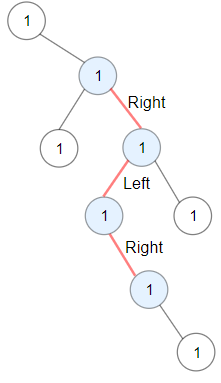
Longest ZigZag Path in a Binary Tree
19 April, 2023
2
2
0
Contributors
Problem Statement:-
You are given the root of a binary tree.
A ZigZag path for a binary tree is defined as follow:
- Choose any node in the binary tree and a direction (right or left).
- If the current direction is right, move to the right child of the current node; otherwise, move to the left child.
- Change the direction from right to left or from left to right.
- Repeat the second and third steps until you can't move in the tree.
Zigzag length is defined as the number of nodes visited - 1. (A single node has a length of 0).
Return the longest ZigZag path contained in that tree.
Link: https://leetcode.com/problems/longest-zigzag-path-in-a-binary-tree/description/
Problem Explanation with examples:-
Example 1

Input: root = [1,null,1,1,1,null,null,1,1,null,1,null,null,null,1,null,1]
Output: 3
Explanation: Longest ZigZag path in blue nodes (right -> left -> right).Example 2

Input: root = [1,1,1,null,1,null,null,1,1,null,1]
Output: 4
Explanation: Longest ZigZag path in blue nodes (left -> right -> left -> right).Example 3
Input: root = [1]
Output: 0Constraints
- The number of nodes in the tree is in the range
[1, 5 * 104]. 1 <= Node.val <= 100
Intuition:-
- The longest zigzag path can be found by traversing the tree in a depth-first manner and keeping track of the longest zigzag path seen so far.
- A stack is used to keep track of the nodes in the tree and the number of zigzags seen so far.
- The stack is initialized with the root node and the number of zigzags seen so far is 0.
- The stack is popped until it is empty. At each iteration, the current node, the number of zigzags seen so far, and a boolean left is popped from the stack.
- If the current node is not None, the longest zigzag path seen so far is updated by comparing it with the number of zigzags seen so far.
- The left child and the right child of the current node are pushed to the stack with the number of zigzags seen so far as 1 if left is True and n + 1 if left is False.
- The longest zigzag path seen so far is returned.
Solution:-
- Initialize ans to 0.
- Initialize a stack and push the root node and the number of zigzags seen so far as 0 to the stack.
- While the stack is not empty, pop the current node, the number of zigzags seen so far and a boolean left from the stack.
- If the current node is not None, update ans by maximum of ans and n.
- Push the left child of the current node to the stack with the number of zigzags seen so far as 1 if left is True and n + 1 if left is False. The boolean left is set to True.
- Push the right child of the current node to the stack with the number of zigzags seen so far as n + 1 if left is True and 1 if left is False. The boolean left is set to False.
- Return ans.
Code:-
JAVA Solution
class Solution {
public String mergeAlternately(String word1, String word2) {
int i = 0;
int j = 0;
StringBuilder ans = new StringBuilder();
while (i < word1.length() && j < word2.length()) {
ans.append(word1.charAt(i)).append(word2.charAt(j));
i++;
j++;
}
while (i < word1.length()) {
ans.append(word1.charAt(i));
i++;
}
while (j < word2.length()) {
ans.append(word2.charAt(j));
j++;
}
return ans.toString();
}
}Python Solution
class Solution:
def longestZigZag(self, root: Optional[TreeNode]) -> int:
ans = 0
stack = [(root, 0, None)]
while stack:
node, n, left = stack.pop()
if node:
ans = max(ans, n)
stack.append((node.left, 1 if left else n + 1, 1))
stack.append((node.right, n + 1 if left else 1, 0))
return ansComplexity Analysis:-
TIME:-
The time complexity of the given Python code is O(N) where N is the number of nodes in the tree, as we visit every node exactly once.
SPACE:-
The space complexity of the code is also O(N) as we need to store all the nodes in the worst case (i.e., a skewed tree).
References:-
Connect with me:-
java
python
leetcode
dsa
